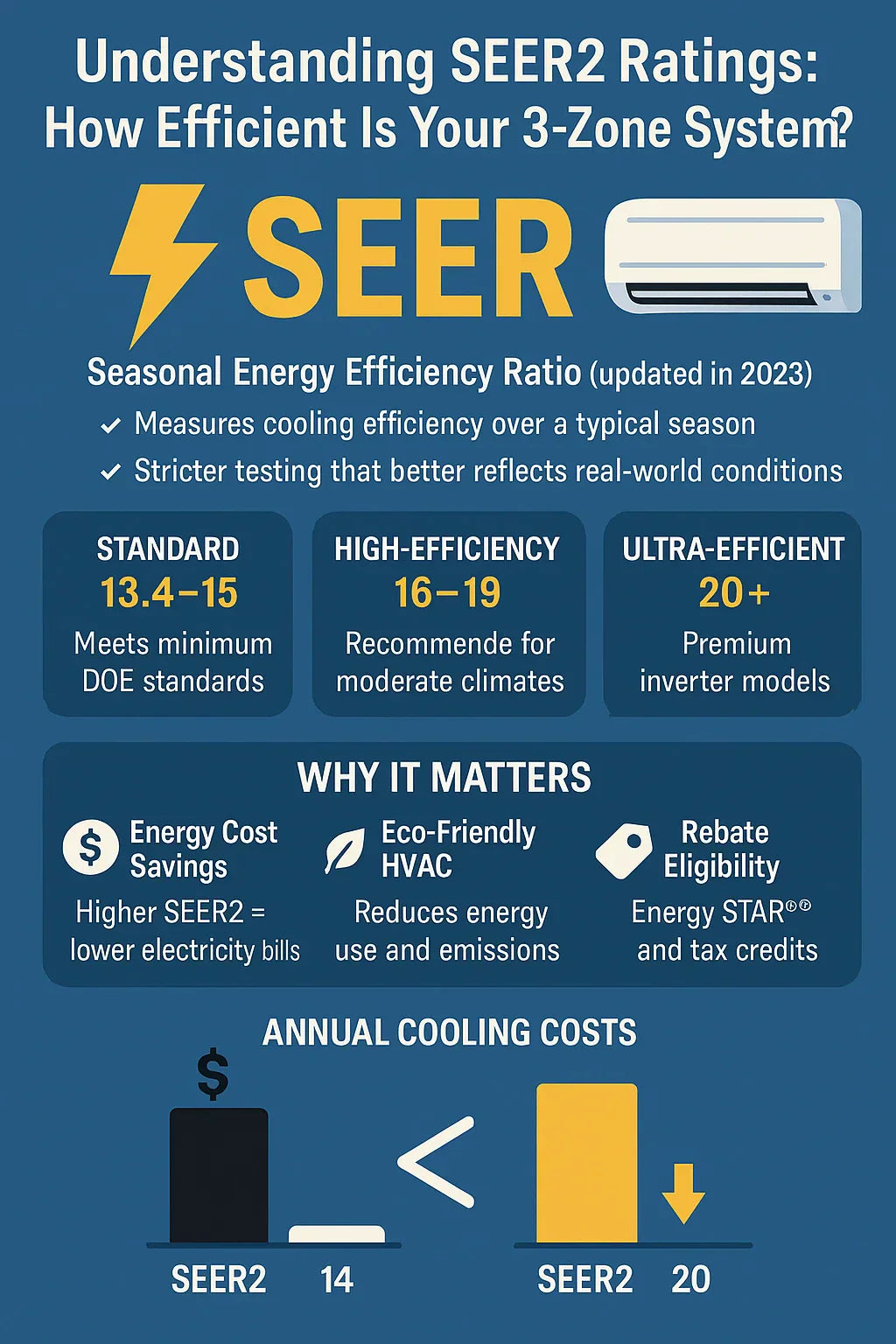If you’re Jake, a homeowner who wants efficient comfort without wasting money, then SEER2 should be more than just a sticker on your mini split box—it should guide your entire buying decision. This article breaks down what SEER2 really means, how it affects energy bills, and how to compare systems so your 3-zone setup delivers maximum performance per dollar.
📊 What Is SEER2—and How Is It Different from SEER?
➕ SEER = Seasonal Energy Efficiency Ratio
Old formula (pre-2023): Measures cooling output per watt-hour over a season, based on ideal lab conditions.
➕ SEER2 = Updated Standard from 2023 Onward
New formula: Introduced by the U.S. Department of Energy, SEER2 uses stricter testing conditions that better simulate real-world airflow and static pressure.
✅ SEER2 = Lower number than SEER, but more accurate for homeowners.
📎 Source: Energy.gov SEER2 Testing Standards
💡 Why Should Jake Care About SEER2?
💸 Energy Cost Savings
Higher SEER2 = Lower electricity bills. A system with SEER2 21 can be up to 40% more efficient than one with SEER2 14.
Example: If your system uses 3,000 kWh/year, a jump from SEER2 14 to 20 could save $300+ annually (at $0.15/kWh).
🌿 Eco-Friendly HVAC
Efficient systems use less power, reduce grid strain, and minimize greenhouse gas emissions—especially helpful in hot climates.
🏷️ Rebate Eligibility
Only SEER2-qualified units earn ENERGY STAR® and are eligible for federal tax credits and local utility rebates.
📎 See: ENERGY STAR Certified Products
🧊 What SEER2 Ratings Should You Expect for 3-Zone Systems?
| Efficiency Level | SEER2 Range | Description | Typical Price Tag |
|---|---|---|---|
| Standard | 13.4–15 | Meets DOE minimums (legal baseline) | Budget systems ($4k–$6k) |
| High-Efficiency | 16–19 | Great balance of performance & cost | Mid-tier ($6k–$8k) |
| Ultra-Efficient | 20+ | Premium systems with inverter tech | Premium ($8k–$11k) |
📎 Tip: SEER2 ratings can vary by indoor head combo—not just the outdoor unit.
🔍 SEER2 by Brand (2025 Models)
| Brand | Typical SEER2 for 3-Zone Systems | Notes |
|---|---|---|
| MRCOOL DIY | 18.5–20.5 | Great for DIY installs |
| Mitsubishi | 19–22 | Inverter-driven, cold-climate ready |
| Gree | 17–20 | Budget + performance options |
| Daikin | 18–23 | Smart sensors, premium pricing |
| Pioneer | 16–19 | Cost-effective for smaller homes |
📎 Verified specs: AHRI Directory of Certified Equipment
⚙️ What Impacts Real-World Efficiency?
1. How Many Zones You Use at Once
Running all 3 heads together draws more power than using 1–2. Use zoning wisely.
2. Line Set Length & Installation
Longer or poorly insulated lines = higher heat loss = lower efficiency.
3. Fan Speed & Inverter Operation
Inverter compressors modulate output smoothly, avoiding the waste of constant on/off cycles.
4. Filter Maintenance
Clogged filters increase system load—clean every 30–60 days to maintain SEER2 performance.
💬 Jake’s Example Scenario
Jake installs a 36,000 BTU MRCOOL 3-zone system with SEER2 20 in Kentucky.
-
Old system SEER: 13
-
Usage: 2,800 cooling kWh/year
-
New SEER2 Savings:
-
Old: 2,800 kWh
-
New: ~1,820 kWh
-
Savings = 980 kWh x $0.14 = $137/year
-
📎 Calculator: HVAC.com SEER2 Energy Savings Tool
🔌 What About HSPF2? (Heating Ratings)
HSPF2 = Heating Seasonal Performance Factor
-
Measures winter heating efficiency (applies to heat pumps only)
-
HSPF2 ≥ 9 is recommended for cold climates
📎 Source: DOE Heating Efficiency Changes 2023
✅ Buying Tips for SEER2-Conscious Shoppers
-
Look for SEER2 ≥ 17 for moderate climates
-
If you're in a hot/humid region (Zone 1–2), aim for SEER2 ≥ 19
-
Match system capacity to room loads—don’t oversize
-
Check SEER2 values for each head combo, not just condenser specs
-
Use AHRI Directory to cross-check actual system performance
-
Look for ENERGY STAR logo to ensure rebate eligibility
📈 Bottom Line: What’s a “Good” SEER2 for Jake?
| Climate | Minimum SEER2 | Ideal Range |
|---|---|---|
| Cold/Temperate | 15 | 17–20 |
| Warm/Hot | 16 | 19–22+ |
| High-Use Homes | 18 | 20–23 |
Your 3-zone system is only as good as its real-world efficiency—and SEER2 is the most honest metric we’ve got in 2025. Prioritize it, verify it, and factor it into both cost and comfort.
Need help comparing two system specs? Just send the model numbers and I’ll pull the SEER2 ratings and savings for you.
In the next topic we will know more about: Can a 3-Zone System Handle Cold Winters and Hot Summers?







